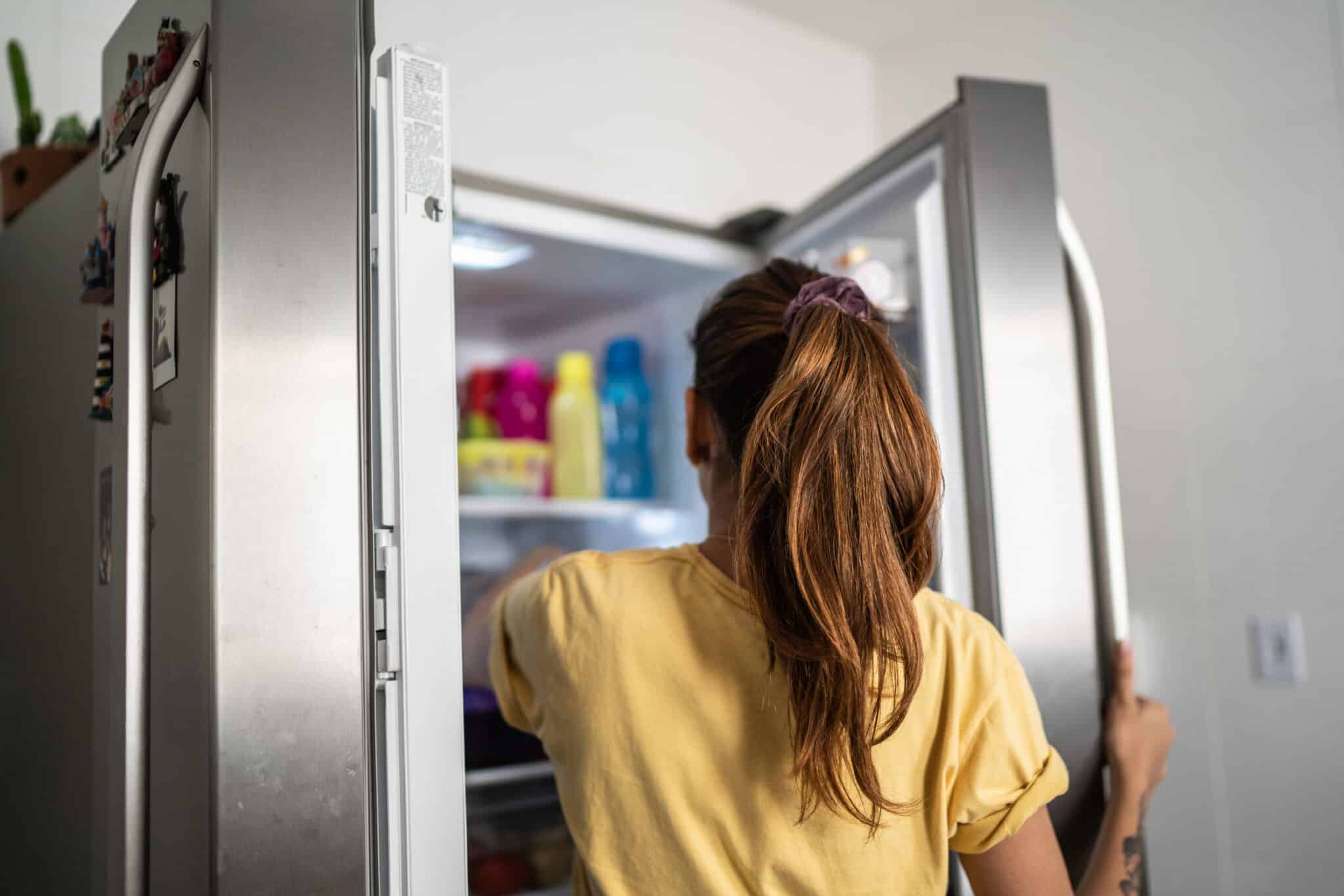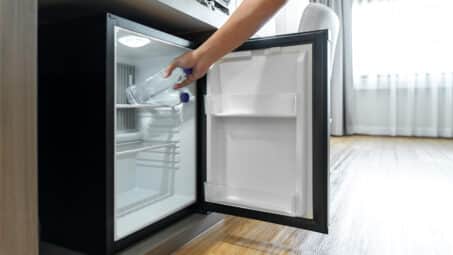Refrigerator maintenance is one of the most important tasks that you can do in your home. Your refrigerator runs constantly to keep your food cold and safe to eat, so you need to make sure it stays working efficiently at all times.
Proper refrigerator maintenance may also help your hard-working appliance to last longer. And because purchasing a new or even a pre-owned fridge can be costly, it’s worthwhile to extend the life of the fridge you have for as long as you can.
Fortunately, refrigerator maintenance is easy to do, and isn’t very time-consuming. So, if you’re ready to get your fridge into shape, here are nine quick and easy tips to help keep your fridge running smoothly:
1. Monitor Your Fridge’s Temperature
Food is expensive, and the last thing you want is to have to throw it away because your fridge or freezer got too warm. Your fridge needs to have the correct temperature for food safety at all times, so monitoring the temperature is very important.
According to the U.S. Food & Drug Administration, your refrigerator should be at or below 40 degrees F, and the freezer should stay at 0 degrees F.
So, an important first step in refrigerator maintenance is the check the temperature. A fridge and freezer thermometer will allow you to do this every time you open the door. This specific kind of thermometer will also indicate on the dial when temperatures are outside of safe food storage ranges.
If the temperature drops too low or climbs too high you may have a problem. If that happens, you can move onto the basic refrigerator maintenance tasks listed in this article to see if they solve the issue.
2. Keep the Condenser Coils Clean
Condenser coils are on the outside of the fridge. They expel the heat in the refrigerant, keeping the inside of the refrigerator cool.
But, dirty condenser coils work inefficiently, and refrigerator condenser coils clog up with dust, dirt, and pet hair over time. Cleaning them regularly as part of your refrigerator maintenance will help your refrigerator to run more smoothly.
The condenser coils are typically on the back of a refrigerator or on the bottom.
If your condenser coils are on the back of your refrigerator: You access coils by pulling the refrigerator forward. Fortunately, most refrigerators are on wheels, so they typically roll pretty easily, but you can also ask someone for help to move the appliance.
If your condenser coils are on the bottom of your refrigerator: You access coils by removing a cover or grill; check your owner’s manual to see how to remove the cover or grill without damaging it. (You can usually find owner’s manuals for your appliances on the manufacturer’s website.)
To clean the coils, use a refrigerator coil cleaning brush. This special tapered brush removes the dirt and grime that gets stuck in the coils. Or, you can use a vacuum with the brush attachment, which makes tackling this refrigerator maintenance task easier.
3. Check the Fridge Door Gaskets
The door on your fridge has a gasket around the inside to seal the cool air inside the appliance. Unfortunately, over time, the seal can loosen, allowing the cold air to escape.
This causes three issues:
- Your fridge will have to use more energy and work harder to stay cool
- Your power bill will probably go up
- You may have to toss food that has become too warm
So, as part of your refrigerator maintenance, you should check the fridge door gasket on a regular basis to make sure that it’s clean and free of cracks. And then you should clean the seal at least twice a year.
To clean your fridge’s door gasket:
- Mix a small amount of baking soda with warm water
- Dip an old toothbrush, or microfiber cleaning cloth in the solution
- Gently scrub the seals to remove residue
- Go over the seals with a damp cloth
- Dry the seals with a dry cloth
Once you’ve cleaned the seals, it’s time for the “dollar-bill test.” Close a dollar bill (any other denomination is fine) into the door, so that half of the bill is peeking out. If the money slips down or out of the door, your seals aren’t working properly.
You may be able to replace the seals yourself or you can call a professional appliance repairperson to replace them.
4. Keep Your Food Covered
Placing leftovers and other foods into storage containers with lids keeps everything fresher longer. But did you know it’s also an important part of refrigerator maintenance?
Putting warm, uncovered food into a refrigerator will create moisture. And too much moisture can lead to a musty odor, and the build-up of mold and mildew.
To prevent this from happening, simply cover your food. You can cover bowls or plates with aluminum foil or plastic wrap, or you can purchase a set of food storage containers with lids.
For example, the Pyrex 18-piece Glass Food Storage Container Set with Lids is durable and safe for the fridge or freezer.
These containers:
- Are made from tempered glass
- Are stain resistant
- Come with BPA-free and colorful plastic lids
The glass storage dishes are safe to use in the microwave and dishwasher, and they’re reusable.
5. Change the Water Filter Regularly
Refrigerators with a water dispenser and an ice maker typically have a water filter. If your fridge has one of these, you should change this filter regularly as part of your refrigerator maintenance.
Not only will keeping the filter clean give you the best quality water and ice, but it will also allow these parts to run as efficiently as possible.
Consult your refrigerator’s owner’s manual to check how often you should change the filter. If the manual doesn’t specify an interval, change it every three months to keep the filter fresh.
6. Keep the Fridge Away From Heat Sources
Your refrigerator needs to be positioned away from hot appliances like the oven, stove, range, or heater. This is because being close to these heat sources will make the fridge have to work harder, and use more energy to stay cool.
Granted, you may not be able to move your refrigerator to a new location as many kitchens have specified spots for the fridge built in around cabinets and counters. However, if you do have options, move the fridge as far away from heat-generating sources as you can.
7. Keep It Three-Quarters Full
A refrigerator needs to have things inside of it in order to work most efficiently because the foods you keep inside your fridge absorb the cold air, which helps cool the other foods.
A mostly empty fridge will have to work harder to keep those things cool. And if your fridge is on the empty side, you may find that the food that’s in there isn’t cold enough. Or on the other hand, the food may freeze.
To prevent these issues from happening, try to keep your fridge about three-quarters full of food and beverages whenever possible.
Granted, there are times when you may be behind on your grocery shopping, or perhaps you don’t do a lot of cooking and so the fridge is commonly pretty empty. In these cases, consider placing some jugs of water into the fridge to fill up the spaces, and keep the fridge running efficiently.
While keeping the fridge mostly full is a key part of refrigerator maintenance, you don’t want the appliance to be too full. The cold air needs to circulate around the food and beverages to keep everything at the optimum temperature. And jam-packing a fridge with food can block air vents, which again will cause the air to not be able to move around inside the appliance.
An easy way to tell that the fridge is too full is by checking the thermometer. When the temperature inside the refrigerator starts to rise, it may be because there’s too much inside of it and the vents are blocked. In this case, move the food away from the vents, and use up some of the food as soon as you can so that the fridge is less full.
8. Make Sure the Fridge Is Level
Most refrigerators are on wheels or feet, which can shift over time and cause the appliance to be uneven.
A fridge that isn’t even can make the door harder to close, and the inner gasket seal will have difficulty doing its job.
Use a level tool like the 9-in Box Torpedo Level from Craftsman several times a year as part of your refrigerator maintenance to check that your fridge is even. Simply place it on top of the fridge, or on one of the shelves inside.
Adjust the feet or wheels as necessary to make the fridge even. Consult the owner’s manual on how to do this correctly and safely.
9. Wipe Down the Shelves
The shelves inside you refrigerator will often get dirty and sticky. And while this won’t impact the ability of the appliance to cool your food, it can look unsightly, and whatever spilled could also cause other foods to become contaminated.
You can spot-clean spilled juice, spaghetti sauce, and other foods and beverages as they occur. But additionally, do a thorough cleaning of all of the shelves and bins in the doors at least a couple of times a year.
It’s best to choose a fridge interior cleaning option that allows you to complete the job quickly. This way, you won’t lose a lot of cold air by keeping the doors open for a long time.
For instance, instead of using a soapy washcloth to clean the shelves followed by a rinse with plain water, clean the shelves with Clorox Free & Clear Compostable Cleaning Wipes.
These wipes:
- Don’t require a rinse
- Are bleach-free and safe to use around food
- Dissolve grease and grime
- Are gentle on fridge shelf surfaces
- Are made with a plant-based cloth that is compostable.
It’s recommended to move food to different areas of the fridge as you clean, or lift up each item as you go and wipe the shelf underneath.
Refrigerator Maintenance Is “Cool”
Performing these important refrigerator maintenance tasks is a “cool” thing to do. Food is more expensive than ever, so you’ll want your fridge working as efficiently as possible to protect your perishables.
By following these tips and making sure the condenser coils are clean, the fridge and freezer are cold enough, food is properly stored, the fridge is adequately full and more, you can rest assured your fridge will continue to keep food cold, and last as long as possible.






